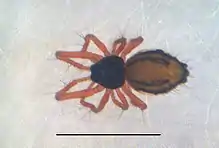Symphytognathidae
Symphytognathidae is a family of spiders with 73 described species in eight genera. They occur in the tropics of Central and South America and the Australian region (with Oceania). Exceptions include Anapistula benoiti, Anapistula caecula, and Symphytognatha imbulunga, found in Africa, Anapistula ishikawai, found in Japan, and Anapistula jerai, found in Southeast Asia.[1]
| Dwarf orb-weavers | |
|---|---|
 | |
| Crassignatha danaugirangensis, female | |
| Scientific classification | |
| Kingdom: | Animalia |
| Phylum: | Arthropoda |
| Subphylum: | Chelicerata |
| Class: | Arachnida |
| Order: | Araneae |
| Infraorder: | Araneomorphae |
| Family: | Symphytognathidae Hickman, 1931 |
| Diversity | |
| 8 genera, 73 species | |
 | |
The species Patu digua is considered to be one of the smallest spiders in the world with a body size of 0.37 millimetres (0.015 in).[2]
Morphology
Symphytognathidae are four-eyed spiders and are generally small in size.
Genera
As of April 2019, the World Spider Catalog accepts the following genera:[1]
- Anapistula Gertsch, 1941 — Asia, South America, Portugal, Oceania, Africa, North America, Jamaica
- Anapogonia Simon, 1905 — Indonesia
- Crassignatha Wunderlich, 1995 — Indonesia, Malaysia
- Curimagua Forster & Platnick, 1977 — Panama, Venezuela
- Globignatha Balogh & Loksa, 1968 — Brazil, Belize
- Iardinis Simon, 1899 — Nepal, India
- Patu Marples, 1951 — Asia, Colombia, Oceania, Seychelles
- Symphytognatha Hickman, 1931 — Oceania, South America, Caribbean, Mexico, Belize, South Africa
References
- "Family: Symphytognathidae Hickman, 1931". World Spider Catalog. Natural History Museum Bern. Retrieved 2019-04-25.
- Forster, R. R.; Platnick, N. I. (1977). "A review of the spider family Symphytognathidae (Arachnida, Araneae)" (PDF). American Museum Novitates. 2619: 20.
| Wikispecies has information related to Symphytognathidae. |
This article is issued from Wikipedia. The text is licensed under Creative Commons - Attribution - Sharealike. Additional terms may apply for the media files.